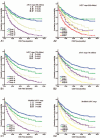Modified staging classification for intrahepatic cholangiocarcinoma based on the sixth and seventh editions of the AJCC/UICC TNM staging systems
- PMID: 28834905
- PMCID: PMC5572027
- DOI: 10.1097/MD.0000000000007891
Modified staging classification for intrahepatic cholangiocarcinoma based on the sixth and seventh editions of the AJCC/UICC TNM staging systems
Abstract
Intrahepatic cholangiocarcinoma (ICC) was differentiated from hepatocellular carcinoma, as defined in the American Joint Committee on Cancer (AJCC) 6th edition staging manual, using the revised staging system described in the AJCC 7th edition staging manual. This study was conducted to analyze the application of the AJCC 6th and 7th edition staging classifications and to evaluate a modified staging classification to potentially reduce the limitations associated with the different AJCC staging systems.We compared the prognostic value of cancer staging using data from the Surveillance, Epidemiology, and End Results database (N = 2124). The Kaplan-Meier method and Cox regression models were used to analyze survival. The Harrell concordance index (C-index) was used to analyze the discriminative abilities of cancer staging.Patients with stages I and II disease were found to have similar prognoses according to the 6th edition staging system. Using the 7th edition staging system, a low proportion of patients had stage III disease (5.0%), and the hazard ratio (HR) for stage III disease was comparable to that of stage IV disease (stage III and IV, 2.653 and 2.694). We modified the AJCC staging classification by adopting the 7th edition T, N, and M definitions and the 6th edition staging definitions. Consequently, the proportion of patients with stage III disease increased (22.8%). The HR for stage IV disease was higher than that for stage III disease (stage III and IV, 2.425 and 2.956). Meanwhile, the C-index of the modified AJCC staging system was 0.721 (95% CI: 0.696-0.745), which was significantly higher than the AJCC 7th edition staging system (0.694, P < .001), and the AJCC 6th edition staging system (0.712, P = .033). Moreover, in the stratified data, the differences between the stages identified using the modified AJCC staging classification were significant, especially among patients over 60 years in age, white patients and patients who underwent surgery.These findings suggest that the modified AJCC staging classification may be applicable to the staging of ICC and can be adopted in clinical practice.
Conflict of interest statement
The authors have no conflicts of interest to disclose.
Figures


Similar articles
-
American Joint Committee on Cancer staging for resected perihilar cholangiocarcinoma: a comparison of the 6th and 7th editions.HPB (Oxford). 2014 Dec;16(12):1074-82. doi: 10.1111/hpb.12320. Epub 2014 Sep 29. HPB (Oxford). 2014. PMID: 25267346 Free PMC article.
-
Evaluation of the 8th edition American Joint Commission on Cancer (AJCC) staging system for patients with intrahepatic cholangiocarcinoma: A surveillance, epidemiology, and end results (SEER) analysis.J Surg Oncol. 2017 Nov;116(6):643-650. doi: 10.1002/jso.24720. Epub 2017 Jun 12. J Surg Oncol. 2017. PMID: 28608424
-
Comparative performances of the 7th and the 8th editions of the American Joint Committee on Cancer staging systems for intrahepatic cholangiocarcinoma.J Surg Oncol. 2017 May;115(6):696-703. doi: 10.1002/jso.24569. Epub 2017 Feb 14. J Surg Oncol. 2017. PMID: 28194791
-
Intrahepatic cholangiocarcinoma: the AJCC/UICC 8th edition updates.Chin Clin Oncol. 2018 Oct;7(5):52. doi: 10.21037/cco.2018.07.03. Epub 2018 Jul 12. Chin Clin Oncol. 2018. PMID: 30180751 Review.
-
Staging of intrahepatic cholangiocarcinoma.Curr Opin Gastroenterol. 2010 May;26(3):269-73. doi: 10.1097/MOG.0b013e328337c899. Curr Opin Gastroenterol. 2010. PMID: 20179593 Review.
Cited by
-
A blood-based noninvasive miRNA signature for predicting survival outcomes in patients with intrahepatic cholangiocarcinoma.Br J Cancer. 2022 May;126(8):1196-1204. doi: 10.1038/s41416-022-01710-z. Epub 2022 Jan 25. Br J Cancer. 2022. PMID: 35079106 Free PMC article.
-
Prognostic value of site-specific metastases for patients with advanced intrahepatic cholangiocarcinoma: A SEER database analysis.Medicine (Baltimore). 2019 Dec;98(49):e18191. doi: 10.1097/MD.0000000000018191. Medicine (Baltimore). 2019. PMID: 31804337 Free PMC article.
-
High expression of C10orf91 and LINC01224 in hepatocellular carcinoma and poor prognosis.Am J Transl Res. 2022 Apr 15;14(4):2567-2579. eCollection 2022. Am J Transl Res. 2022. PMID: 35559369 Free PMC article.
-
Outcomes assessment in intrahepatic cholangiocarcinoma using qualitative and quantitative imaging features.Cancer Imaging. 2020 Jul 3;20(1):43. doi: 10.1186/s40644-020-00323-0. Cancer Imaging. 2020. PMID: 32620153 Free PMC article.
-
Association between Homologous Recombination Repair Defect Status and Long-Term Prognosis of Early HER2-Low Breast Cancer: A Retrospective Cohort Study.Oncologist. 2024 Jul 5;29(7):e864-e876. doi: 10.1093/oncolo/oyae021. Oncologist. 2024. PMID: 38366907 Free PMC article.
References
-
- Welzel TM, McGlynn KA, Hsing AW, et al. Impact of classification of hilar cholangiocarcinomas (Klatskin tumors) on the incidence of intra- and extrahepatic cholangiocarcinoma in the United States. J Natl Cancer Inst 2006;98:873–5. - PubMed
-
- Bergquist A, von Seth E. Epidemiology of cholangiocarcinoma. Best Pract Res Clin Gastroenterol 2015;29:221–32. - PubMed
-
- Zhang H, Yang T, Wu M, et al. Intrahepatic cholangiocarcinoma: epidemiology, risk factors, diagnosis and surgical management. Cancer Lett 2016;379:198–205. - PubMed
-
- Meng ZW, Han SH, Zhu JH, et al. Risk factors for cholangiocarcinoma after initial hepatectomy for intrahepatic stones. World J Surg 2017;41:835–43. - PubMed
Publication types
MeSH terms
LinkOut - more resources
Full Text Sources
Other Literature Sources
Medical

